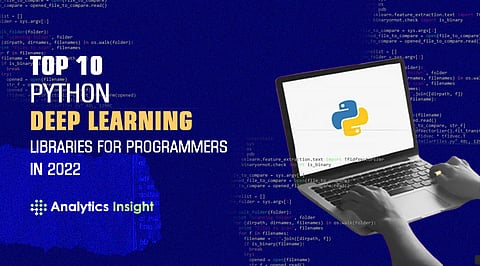

Python continues to lead the way when it comes to operating in machine learning, artificial intelligence, deep learning, and data science. The programming world is stumped by the growth and influence of Python, and its vast use cases are making it even easier for beginners and freshers in the domain to choose Python as the first programming language to learn. With its extensive implementation in the world of computer science, several Python libraries have emerged that have proven to be the most popular among machine learning and deep learning professionals. In this article, we have listed the top Python deep learning libraries for programmers in 2022.
TensorFlow is an open-source library for deep learning applications built by the Google Brain Team. Initially conceived for numeric computations, it now provides a rich, flexible and wide range of tools, libraries, and community resources that developers may use to create and deploy machine learning-based applications. TensorFlow 2.5.0, which was first released in 2015, has just been updated by the Google Brain team to include new functionality.
PyTorch is one of the most popular open-source deep learning libraries, created in 2016 by Facebook's AI research team. The name of the respective library is based on the popular deep learning framework Torch, scientific computation and scripting tool written in the Lua programming language. PyTorch allows you to implement deep learning tasks and allows you to creates computer vision and NLP applications.
Keras is a well-known open-source library that is primarily used for deep learning-related tasks. It allows for rapid deep neural network testing. Francois Chollet created it, and it was initially launched in 2015. Keras provides tools for constructing models, visualizing graphs, and analyzing datasets. It also includes prelabeled datasets that may be directly imported and loaded. It's simple to use, adaptable and well-suited to exploratory study.
DBSCAN, gradient boosting, support vector machines, and random forests are among the classification, regression, and clustering methods included in SciKit-Learn. For conventional ML and data mining applications, David Cournapeau designed the library on top of SciPy, NumPy, and Matplotlib.
Undoubtedly, NumPy is one of the most popular Python libraries that can be seamlessly used for large multi-dimensional array and matrix processing, with the help of a large collection of high-level mathematical functions. It is quite important for efficient fundamental scientific computations in machine learning and is particularly useful for linear algebra, and other operations.
SciPy is a free and open-source library that is based on NumPy. This is one of the top Python libraries that can be used to perform scientific and technical computing on large datasets. SciPy is accompanied by embedded modules for array optimization and linear algebra.
This is one of the open-source Python libraries which is mainly used in Data Science and machine learning subjects. This library mainly provides data manipulation and analysis tools, which are used for analyzing data using its powerful data structures for manipulating numerical tables and time series analysis.
It is a highly scalable open-source Deep learning framework designed to train and deploy deep neural networks. It is capable of fast model training and supports multiple programming languages such as C, C++, Python, Julia, Matlab, etc.
CNTK (Cognitive Toolkit), formerly known as Computational Network ToolKit and released by Microsoft in 2016, is an open-source deep-learning library used to implement distributed deep learning and machine learning tasks. You can easily combine the most popular predictive models, such as CNN (Convolutional Neural Network), feed-forward DNN (Deep Neural Network), and RNN (Recurrent Neural Network), with the CNTK framework to effectively implement end-to-end deep learning tasks.
Theano is a numerical computation Python library created specifically for machine learning and deep libraries. It enabled efficient definition, optimization, and evaluation of mathematical expressions and matrix calculations to employ multidimensional arrays to build deep learning models.
Floki Inu is Digging its Own Grave Despite Ad Campaign Controversy
Will EU Really Share Its Technology under India, EU Trade and Tech Council?
Fashion in the Metaverse: Will it Take a Nasty Turn Soon?
Cybercriminals are Feasting Over 'Zero-day Hacks' While the World Watches
Top 10 Code Playgrounds Every Web Developer Should Try!
5G Cyberattacks are Menacing! A 9/11 Like Scenario could Unfold Soon
Join our WhatsApp Channel to get the latest news, exclusives and videos on WhatsApp
_____________
Disclaimer: Analytics Insight does not provide financial advice or guidance. Also note that the cryptocurrencies mentioned/listed on the website could potentially be scams, i.e. designed to induce you to invest financial resources that may be lost forever and not be recoverable once investments are made. You are responsible for conducting your own research (DYOR) before making any investments. Read more here.
